Salicornia
| Salicornia | |
|---|---|
| Salicornia europaea | |
| Scientific classification | |
| Kingdom: | Plantae |
| (unranked): | Angiosperms |
| (unranked): | Eudicots |
| (unranked): | Core eudicots |
| Order: | Caryophyllales |
| Family: | Amaranthaceae |
| Subfamily: | Salicornioideae |
| Genus: | Salicornia |
| Species | |
|
See text. | |
Salicornia is a genus of succulent, halophyte (salt tolerant) flowering plants in the family Amaranthaceae that grow in salt marshes, on beaches, and among mangroves. Salicornia species are native to North America, Europe, South Africa, and South Asia. Common names for the genus include glasswort, pickleweed, picklegrass, and marsh samphire; these common names are also used for some species not in Salicornia.[1] To French speakers in Atlantic Canada, they are known, colloquially, as "titines de souris" (mouse tits). The main European species is often eaten, called marsh samphire in Britain, and the main North American species is occasionally sold in grocery stores or appears on restaurant menus, usually as 'sea beans' or samphire greens or sea asparagus .
Description
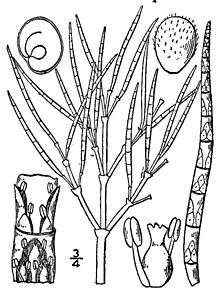
The Salicornia species are small annual herbs. They grow prostrate to erect, their simple or branched stems are succulent, glabrous, and apparently jointed. Older stems may be somewhat woody basally. The opposite leaves are fleshy, glabrous, sessile, basally connate and decurrent and enclosing the stem (thus forming the joints). The leaf blades are reduced to small collar-like scales with narrow scarious margin.[2] Many species are green, but their foliage turns red in autumn.
All stems are terminating in spike-like apparently jointed inflorescences. Each joint consists of two opposite minute bracts with an (1-) 3-flowered cyme tightly embedded in cavities of the main axis and partly hidden by the bracts. The flowers are arranged in a triangle, both lateral flowers beneath the central flower. The hermaphrodite flowers are more or less radially symmetric, with a perianth of three fleshy tepals connate nearly to the apex. There are 1-2 stamens and an ovary with two stigmas.[2]
The perianth is persistent in fruit. The fruit wall (pericarp) is membranous. The vertical seed is ellipsoid, with yellowish brown, membranous, hairy seed coat. The seed contains no perisperm (feeding tissue).[2]
Like most members of the subfamily Salicornioideae, Salicornia species use the C3 carbon fixation pathway to take in carbon dioxide from the surrounding atmosphere.[3]
Distribution and habitat
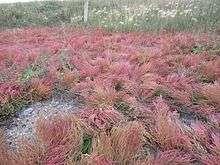
The species of Salicornia are widely distributed over the Northern Hemisphere and in southern Africa, ranging from the subtropics to subarctic regions. They are absent from South America and Australia.[4]
They grow in coastal salt marshes and in inland salty habitats like shores of salt lakes.[4] Salicornia species are halophytes and can generally tolerate immersion in salt water (hygrohalophytes).
Ecology
Salicornia species are used as food plants by the larvae of some Lepidoptera species, including the Coleophora case-bearers C. atriplicis and C. salicorniae (the latter feeds exclusively on Salicornia spp.).
Phylogenetics
The genus probably originated during the Miocene in the region between the Mediterranean basin and Central Asia. Evolving from within the perennial and frost-sensitive genus Sarcocornia, the annual, strongly inbreeding and frost-tolerant Salicornia diversified during the late Pliocene to early Pleistocene. By events of intercontinental dispersals, they reached southern Africa twice, North America at least three times. Two tetraploid lineages expanded rapidly, with the ability to colonize lower belts of the saltmarshes than their diploid relatives. Inbreeding and geographical isolation led to a large number of reproductive isolated species that are only weakly differentiated.[4]
Systematics
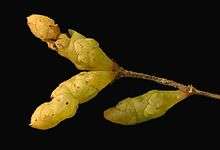
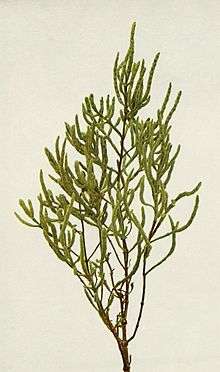
The genus Salicornia was first described in 1753 by Carl Linnaeus.[5] Salicornia europaea was selected as the type species.[6]
The taxonomic classification of this genus is extremely difficult (and has been called a "taxonomic nightmare"), determination of species seems almost impossible for non-specialists. The reasons for those difficulties are the reduced habit with weak morphological differentiation, and high phenotypic variability. As the succulent plants lose their characteristics while drying, herbarium specimens often cannot be determined with certainty and are less suited for taxonomic studies.[4]
Based on molecular genetic research (Kadereit et al. 2007, 2012),[4][7] Salicornia comprises the following species:
- Salicornia europaea species group, Common glasswort, with two cryptic species:
- Salicornia europaea L., with three subspecies
- Salicornia europaea subsp. europaea, along coasts from southern Spain to northern Scandinavia
- Salicornia europaea subsp. disarticulata (Moss) Lambinon & Vanderpoorten, Atlantic coasts of Brittany, the Netherlands and southern England.
- Salicornia europaea subsp. × marshallii Lambinon & Vanderpoorten, the hybrid of both former subspecies, Atlantic coasts of Brittany and the Netherlands
- Salicornia perennans Willd. (Syn. Salicornia prostrata Pallas), with two subspecies:
- Salicornia perennans subsp. perennans, with wide mediterranean-continental distribution, from North Africa and the Mediterranean region to the Baltic Sea and White Sea (occurring locally at coasts of the Atlantic and North Sea), in Asia to Yakutsk (Siberia), Japan, and Korean Peninsula.
- Salicornia perennans subsp. altaica (Lomon.) G. Kadereit & Piirainen, endemic in Altai Mountains (Russia, Mongolia)
- Salicornia europaea L., with three subspecies
- Salicornia procumbens species group:
- Salicornia procumbens Sm., with four subspecies:
- Salicornia procumbens subsp. procumbens, widely distributed along the Mediterranean and Atlantic coasts from Morocco to Scandinavia, inland occurrences in Turkey and Ukraine.
- Salicornia procumbens subsp. freitagii (Yaprak & Yardakulol) G. Kadereit & Piirainen, endemic in Turkey (Anatolia).
- Salicornia procumbens subsp. pojarkovae (Semenova) G. Kadereit & Piirainen, coasts of the White Sea (Russia) and Barents Sea (Norway).
- Salicornia procumbens subsp. heterantha (S.S. Beer & Demina) G. Kadereit & Piirainen, endemic in southeast European Russia (Rostov Oblast).
- Salicornia persica Akhani, with two subspecies:
- Salicornia persica subsp. persica, in Iran
- Salicornia persica subsp. iranica (Akhani) G. Kadereit & Piirainen, in Iran, and probably in eastern Mediterranean and Southwest Asia.
- Salicornia procumbens Sm., with four subspecies:
- Salicornia maritima S.L.Wolff & Jefferies, Slender glasswort, coasts of southeastern Canada, northeastern United States, southern Alaska. (proved to be genetically identical to Salicornia europaea[7])
- Salicornia bigelovii Torrey, Dwarf glasswort, Gulf of Mexico, Atlantic coasts to Maine, southern California.
- Salicornia depressa Standley, (probable synonym Salicornia virginica).[2] Pacific coasts from Alaska to California, Atlantic coasts from Canada to South Carolina.
- Salicornia rubra A.Nelson, salty inland habitats of the central United States and Canada.
In Africa:[4]
- Salicornia praecox A.Chev., western Senegal
- Salicornia senegalensis A.Chev., western Senegal
- Salicornia perrieri A.Chev., East African coasts from Mozambique to KwaZulu-Natal, Madagascar, probably in Tanzania and Zanzibar
- Salicornia pachystachya Bunge ex Ungern-Sternb., East African coasts from southern Kenya to KwaZulu-Natal, Madagascar
- Salicornia meyeriana Moss, South African coasts from Vanrhynsdorp to Durban
- Salicornia uniflora Toelken, southwestern Namibia (Lüderitz) and northwestern South Africa (Darling)
In South Asia:[4]
- Salicornia brachiata Roxb., Umari keerai, coasts of Ceylon and from East India to Bengal.
Culinary
Salicornia europaea is edible, either cooked or raw.[8] In England, it is one of several plants known as samphire (see also Rock samphire); the term samphire is believed to be a corruption of the French name, [herbe de] Saint-Pierre, which means "St. Peter's herb".[9]
Samphire is usually cooked, either steamed or microwaved, and then coated in butter or olive oil. Due to its high salt content, it must be cooked without any salt added, in plenty of water. It has a hard, stringy core, and after cooking, the edible flesh is pulled off from the core. This flesh, after cooking, resembles seaweed in color, and the flavor and texture are like young spinach stems or asparagus. Samphire is often used as a suitably maritime accompaniment to fish or seafood.
In Hawai'i, where it is known as sea asparagus, it is often blanched and used as a topping for salads or accompaniment for fish.[10][11]
In addition to S. europaea, the seeds of S. bigelovii yield an edible oil. S. bigelovii's edibility is compromised somewhat because it contains saponins, which are toxic under certain conditions.[8]
Umari keerai is cooked and eaten or pickled. It is also used as fodder for cattle, sheep and goats.[12] In Kalpitiya, Sri Lanka, it is used to feed donkeys.
On the east coast of Canada, the plant is known as samphire greens and is a local delicacy. In Southeast Alaska, it is known as beach asparagus. In Nova Scotia, Canada, they are known as crow's foot greens. In British Columbia, Canada, they are known as sea asparagus.[13] In the United States, they are known as sea beans when used for culinary purposes. Other names include sea green bean, sea pickle, and marsh samphire.[14]
In India, researchers at the Central Salt and Marine Chemicals Research Institute developed a process to yield culinary salt from Salicornia brachiata. The resulting product is known as vegetable salt and sold under the brand name Saloni.[15]
Pharmacological Research
In South Korea, Phyto Corporation has developed a technology of extracting low-sodium salt from Salicornia europaea, a salt-accumulating plant. The company claims the naturally-derived plant salt is effective in treating high blood pressure and fatty liver disease[16] by reducing sodium intake.[17] The company has also developed a desalted Salicornia powder containing antioxidative and antithrombus polyphenols, claimed to be effective in treating obesity and arteriosclerosis,[18] as well as providing a means to help resolve global food shortages.[19]
Industrial use
Historical
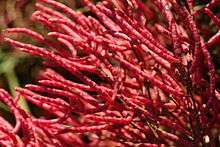
The ashes of glasswort and saltwort plants and of kelp were long used as a source of soda ash (mainly sodium carbonate) for glassmaking and soapmaking. The introduction of the LeBlanc process for industrial production of soda ash superseded the use of plant sources in the first half of the 19th century.
Umari keerai is used as raw material in paper and board factories.[12]
Contemporary
Because Salicornia bigelovii can be grown using saltwater and its seeds contain high levels of unsaturated oil (30%, mostly linoleic acid) and protein (35%),[20][21] it can be used to produce animal feedstuff and as a biofuel feedstock on coastal land where conventional crops cannot be grown. Adding nitrogen-based fertiliser to the seawater appears to increase the rate of growth and the eventual height of the plant,[22] and the effluent from marine aquaculture (e.g. shrimp farming) is a suggested use for this purpose.[20]
Experimental fields of Salicornia have been planted in Ras al-Zawr (Saudi Arabia),[21] Eritrea (northeast Africa) and Sonora (northwest Mexico)[23] aimed at the production of biodiesel. The company responsible for the Sonora trials (Global Seawater) claims between 225 and 250 gallons of BQ-9000 biodiesel can be produced per hectare (approximately 2.5 acres) of salicornia,[24] and is promoting a $35 million scheme to create a 12,000-acre (49 km2) salicornia farm in Bahia de Kino.[25] Stems and roots of Salicornia brachiata plants had high cellulose contents (ca. 30%), whereas tender stem tips contents low cellulose content (9.2%).[26] Salicornia brachiata revealed the dominance of rhamnose, arabinose, mannose, galactose, and glucose, with meager presence of ribose and xylose in their structural polysaccharide.[27]
Environmental uses
Pickleweed is used in Phytoextraction, it is highly effective at removing selenium from soil, which is absorbed by the plant and then released into the atmosphere to be dispersed by prevailing winds.[28] Pickleweed (Salicornia bigelovii) has been found to have average volatilization rates 10-100 times higher than other species.[29]
See also
References
- ↑ To French speakers of Atlantic Canada, Salicornia, Integrated Taxonomic Information System, serial number 20646.
- 1 2 3 4 5 Ball, Peter W. (2004). "Salicornia L.," in Flora of North America: North of Mexico Volume 4: Magnoliophyta: Caryophyllidae, part 1, Editorial Committee of the Flora of North America (Oxford University Press, 2004). ISBN 978-0-19-517389-5. Online version retrieved August 10, 2016.
- ↑ Kadereit, G.; Borsch, T.; Weising, K.; Freitag, H. (2003). "Phylogeny of Amaranthaceae and Chenopodiaceae and the evolution of C4 photosynthesis". International Journal of Plant Sciences. 164 (6): 959–86. doi:10.1086/378649.
- 1 2 3 4 5 6 7 8 Kadereit, G.; Ball, P.; Beer, S.; Mucina, L.; Sokoloff, D.; Teege, P.; Yaprak, A.E.; Freitag, H. (2007). "A taxonomic nightmare comes true: phylogeny and biogeography of glassworts (Salicornia L., Chenopodiaceae)". Taxon. 56 (4): 1143–70. doi:10.2307/25065909.
- ↑ Carl Linnaeus (1753). Species Plantarum, Tomus I: 3. First description of Salicornia, scanned at BHL
- ↑ "Salicornia". Tropicos. Missouri Botanical Garden. Retrieved 2016-08-11.
- 1 2 3 Kadereit, G.; Piirainen, M.; Lambinon, J.; Vanderpoorten, A. (2012). "Cryptic taxa should have names. Reflections on the glasswort genus Salicornia (Amaranthaceae)". Taxon. 61: 1227–39.
- 1 2 "Salicornia", page of the Plants for a Future website. Retrieved July 14, 2007.
- ↑ Davidson, Alan (2002). The Penguin Companion To Food (Penguin), p. 828. ISBN 978-0-14-200163-9. On Food and Cooking: The Science and Lore of the Kitchen, Completely Revised and Updated (Scribner, New York), p. 317. ISBN 978-0-684-80001-1.
- ↑ "Tasting Hawai'i With Moloka'i Chef James Temple: The Other Asparagus... Sea Asparagus". tastinghawaii.com. November 10, 2013. Retrieved September 28, 2018.
- ↑ "Eating Local, Hawaiian-Style: Sea Asparagus and Ahi Poke Omaraisu". spiceboxtravels.com. April 3, 2015. Retrieved September 28, 2018.
- 1 2 Salicornia, oil-yielding plant for coastal belts, The Hindu
- ↑ http://westcoastseaweed.com/
- ↑ Cook's Thesaurus: Sea Vegetables, retrieved 2012-10-08.
- ↑ "Indian scientists produce salt from vegetable". The Economic Times (India). 18 May 2003.
- ↑ Kim, Jae Hwan; Suk, Sujin; Jang, Woo Jung; Lee, Chang Hyung; Kim, Jong-Eun; Park, Jin-Kyu; Kweon, Mee-Hyang; Kim, Jong Hun; Lee, Ki Won (2017). "Salicornia Extract Ameliorates Salt-Induced Aggravation of Nonalcoholic Fatty Liver Disease in Obese Mice Fed a High-Fat Diet". Journal of Food Science. 82 (7): 1765–1774. doi:10.1111/1750-3841.13777. PMID 28608557.
- ↑ Panth, Nisha; Park, Sin-Hee; Kim, Hyun; Kim, Deuk-Hoi; Oak, Min-Ho (2016). "Protective Effect of Salicornia europaea Extracts on High Salt Intake-Induced Vascular Dysfunction and Hypertension". International Journal of Molecular Sciences. 17 (7): 1176. doi:10.3390/ijms17071176. PMC 4964547. PMID 27455235.
- ↑ Won, Kyung Jong; Lee, Kang Pa; Baek, Suji; Cui, Long; Kweon, Mee-Hyang; Jung, Seung Hyo; Ryu, Yun-Kyoung; Hong, Jung Min; Cho, Eun-Ah; Shin, Hwa-Sup; Kim, Bokyung (2017). "Desalted Salicornia europaea extract attenuated vascular neointima formation by inhibiting the MAPK pathway-mediated migration and proliferation in vascular smooth muscle cells". Biomedicine & Pharmacotherapy. 94: 430–438. doi:10.1016/j.biopha.2017.07.108. PMID 28778046.
- ↑ Rahman, Md. Mahbubur; Kim, Myung-Jin; Kim, Jin-Hyoung; Kim, Sok-Ho; Go, Hyeon-Kyu; Kweon, Mee-Hyang; Kim, Do-Hyung (2018). "Desalted Salicornia europaea powder and its active constituent, trans-ferulic acid, exert anti-obesity effects by suppressing adipogenic-related factors". Pharmaceutical Biology. 56 (1): 183–191. doi:10.1080/13880209.2018.1436073. PMID 29521146.
- 1 2 Glenn, Edward P.; Brown, J. Jed; O'Leary, James W. (August 1998). "Irrigating Crops with Seawater" (PDF). Scientific American. USA: Scientific American, Inc. (August 1998): 76–81. Retrieved 2008-11-17.
- 1 2 Clark, Arthur (November–December 1994). "Samphire: From Sea to Shining Seed" (PDF). Saudi Aramco World. Saudi Aramco. Archived from the original (PDF) on 2011-07-26. Retrieved 2008-11-17.
- ↑ Alsaeedi, Abdullah H. (2003 (1424H)). "Di Pattern of Salicornia Vegetative Growth in Relation to Fertilization" (PDF). Journal of King Faisal University. Al-Hassa: King Faisal University. 4 (1): 105–18. Retrieved 2008-11-17.
adequate fertilization increases significantly the relative growth rate especially during the ‘rapid’ phase of the vegetative stage
Check date values in:|year=(help) - ↑ "USIJI Uniform Reporting Document" (PDF). United States Initiative on Joint Implementation (USIJI). c. 1997. Archived from the original (PDF) on 2011-07-26. Retrieved 2008-11-17.
Project Salicornia: Halophyte Cultivation in Sonora
External link in|publisher=(help) - ↑ Ryan C. Christiansen (2008-07-31). "Sea asparagus can be oilseed feedstock for biodiesel". Biomass Magazine. Retrieved 2008-11-17.
- ↑ Dickerson, Marla (2008-07-10). "Letting the sea cultivate the land". Los Angeles Times. Tribune Company. Retrieved 17 November 2008.
- ↑ Sanandiya, Naresh D.; Prasad, Kamalesh; Meena, Ramavatar; Siddhanta, Arup K. (2010-04-01). "Cellulose of Salicornia brachiata". Natural Product Communications. 5 (4): 603–606. ISSN 1934-578X. PMID 20433080.
- ↑ Sanandiya, Naresh D; Siddhanta, A.K (2014). "Chemical studies on the polysaccharides of Salicornia brachiata". Carbohydrate Polymers. 112: 300–7. doi:10.1016/j.carbpol.2014.05.072. PMID 25129748.
- ↑ Eichhorn, Peter H. Raven ; Ray F. Evert ; Susan E. (2011). Biology of plants (8 ed.). New York, NY: Freeman. p. 12. ISBN 9781429219617.
- ↑ Terry, N; Zayed, A. M; De Souza, M. P; Tarun, A. S (2000). "Selenium Inhigherplants". Annual Review of Plant Physiology and Plant Molecular Biology. 51: 401–432. doi:10.1146/annurev.arplant.51.1.401. PMID 15012198.
- BBC Gardener's Question Time - where there is apparently some confusion between the glasswort (marsh samphire, found in Suffolk) and the rock samphire (found in Dorset).
- BBC Good Food Channel - recipes for both marsh samphire and rock samphire.
- Biff Vernon discusses the common confusion between marsh samphire and rock samphire, and reproduces a poem on the subject by William Logan.
- Robert Freedman
- Reforma journal small article about experimental biodiesel fields in Sonora, Mexico
- Lists 'Famine Foods', including Umari Keerai (Salicornia brachiata).
- Seawaterfoundation running a seawaterfarm in Eritrea with Salicornia to produce oil, food and store carbon dioxide
External links

